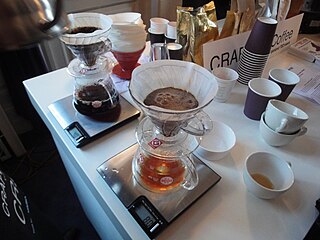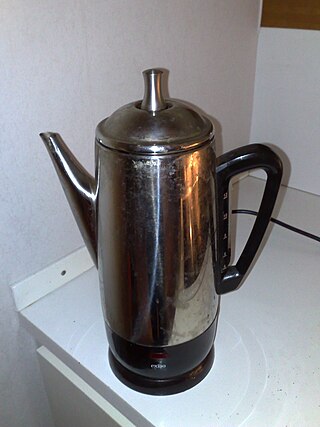
Espresso is a concentrated form of coffee produced by forcing hot water under high pressure through finely-ground coffee beans. Originating in Italy, espresso has become one of the most popular coffee-brewing methods worldwide. It is characterized by its small serving size, typically 25–30 ml, and its distinctive layers: a dark body topped with a lighter-colored foam called crema.

Drip coffee is made by pouring hot water onto ground coffee beans, allowing it to brew while seeping through. There are several methods for doing this, including using a filter. Terms used for the resulting coffee often reflect the method used, such as drip-brewed coffee, or, somewhat inaccurately, filtered coffee in general. Manually brewed drip coffee is typically referred to as pour-over coffee. Water seeps through the ground coffee, absorbing its constituent chemical compounds, and then passes through a filter. The used coffee grounds are retained in the filter, while the brewed coffee is collected in a vessel such as a carafe or pot.

A coffee percolator is a type of pot used for the brewing of coffee by continually cycling the boiling or nearly boiling brew through the grounds using gravity until the required strength is reached. The grounds are held in a perforated metal filter basket.

An espresso machine brews coffee by forcing pressurized water near boiling point through a "puck" of ground coffee and a filter in order to produce a thick, concentrated coffee called espresso. Multiple machine designs have been created to produce espresso. Several machines share some common elements, such as a grouphead and a portafilter. An espresso machine may also have a steam wand which is used to steam and froth liquids for coffee drinks such as cappuccino and caffè latte.

Senseo is a registered trademark for a coffee brewing system from Dutch companies Philips and Douwe Egberts. The system is known for the coffee pods it uses to brew the coffee.

Coffee service refers to the many and various styles in which coffee is made available to people, such as in restaurants and hotels. In particular, it sometimes refers to the set of dishes and vessels utilized to serve and consume coffee, akin to the notion of a tea service.

Mr. Coffee is a brand of automatic drip-brew kitchen coffee machines and other kitchen appliances owned by Newell Brands. Founded in the early 1970s to make a pioneering coffeemaker, Mr. Coffee established itself as the industry's top-selling brand through a promotional relationship with former New York Yankee great Joe DiMaggio, a Major League Baseball Hall of Famer held in high regard by that era's consumers. It subsequently expanded into other kitchen products, such as a related tea maker, juicer, and food dehydrator, and integrated wireless technology into a "smart" version of its coffeemaker. Mr. Coffee is a registered trademark.

The Neapolitan flip coffee pot or cafetière Morize is a drip brew coffeemaker for the stove top invented in Paris and very popular in France and Italy until the 20th century. Unlike a moka express, it does not use the pressure of steam to force the water through the coffee, relying instead on gravity.
Bunn-O-Matic Corporation is an American manufacturer of dispensed beverage equipment headquartered in Springfield, Illinois, with a plant in Creston, Iowa. Currently, the corporation's products are sold under the BUNN and Bunn-O-Matic brands. The current president and CEO is Arthur H. Bunn.

Coffee preparation is the process of turning coffee beans into liquid coffee. While the particular steps vary with the type of coffee and with the raw materials, the process includes four basic steps: raw coffee beans must be roasted, the roasted coffee beans must then be ground, and the ground coffee must then be mixed with hot or cold water for a specific time (brewed), the liquid coffee extraction must be separated from the used grounds, and finally, if desired, the extracted coffee is combined with other elements of the desired beverage, such as sweeteners, dairy products, dairy alternatives, or toppings.

A single-serve coffee container is a container filled with coffee grounds, used in coffee brewing to prepare only enough coffee for a single portion. Single-serve coffee containers come in various formats and materials, often either as hard and soft pods or pads made of filter paper, or hard aluminium and plastic capsules.

The Chemex Coffeemaker is a manual pour-over style glass coffeemaker, invented by Peter Schlumbohm in 1941, manufactured by the Chemex Corporation in Chicopee, Massachusetts.

A coffeemaker, coffee maker or coffee machine is a cooking appliance used to brew coffee. While there are many different types of coffeemakers, the two most common brewing principles use gravity or pressure to move hot water through coffee grounds. In the most common devices, coffee grounds are placed into a paper or metal filter inside a funnel, which is set over a glass or ceramic coffee pot, a cooking pot in the kettle family. Cold water is poured into a separate chamber, which is then boiled and directed into the funnel and allowed to drip through the grounds under gravity. This is also called automatic drip-brew. Coffee makers that use pressure to force water through the coffee grounds are called espresso makers, and they produce espresso coffee.

A chorreador is a coffee making device used in Costa Rica in which hot water leaches through coffee grounds held in a cloth filter mounted on a wooden stand, then drips into a container.

Cold brew coffee, also called cold water extraction or cold pressing, is the process of steeping coffee grounds in water at cool temperatures for an extended period. Coarse-ground beans are soaked in water for about 12 to 24 hours.
Samuel Lewis Glazer was an American businessman, investor, and philanthropist. Glazer founded North American Systems with his business partner, Vincent Marotta Sr. and the two also co-developed Mr. Coffee, one of the first automatic drip coffee makers to be introduced to the American consumer market. Through their firm, Glazer and Marotta hired the engineers, Edmund Abel and Erwin Schulze of Westinghouse, whose research produced the first Mr. Coffee machines.
Edmund Angel Abel, Jr. was an American engineer and inventor who designed and patented the heating element for Mr. Coffee, one of the first automatic drip coffee makers to be introduced to the American consumer market. Mr. Coffee, which was first sold in 1972, soon became the dominant coffeemaker in the United States, reaching sales of approximately $150 million by the late 1970s. Abel's invention, the heating element, brewed a milder coffee than traditional methods, largely replaced the percolator in American homes. Home Furnishings News listed Mr. Coffee as one of the most important household consumer products introduced in the previous seventy-five years in a list published in 2002. Prior to his work on the coffeemaker, he held patents in film developing and aviation. Despite his role in the invention of the Mr. Coffee machine, Abel did not drink coffee.
Vincent George Marotta Sr. was an American businessman, investor and philanthropist. He was the co-creator of Mr. Coffee, one of the first automatic drip coffee makers to be introduced to the American consumer market. Marotta, who conceived the idea for the Mr. Coffee machine, developed it with his business partner, Samuel Glazer, to replace the slower, more challenging percolator for use in homes. Marotta and Glazer began marketing Mr. Coffee in 1972. Marotta, who was responsible for much of the company's marketing as chairman and CEO, recruited Joe DiMaggio to appear in a series of Mr. Coffee television commercials. By 1979, just seven years after its launch, sales of Mr. Coffee accounted for 50% of the U.S. consumer coffee maker market at $150 million.
Technivorm is a family-owned Dutch manufacturer founded by Gerard-Clement Smit in Amerongen, The Netherlands. It produces Moccamaster, a drip coffee maker designed in 1968 and first released in 1969. In 2017, the 10-millionth Moccamaster was sold. As of 2019, Technivorm and Moccamaster have approximately 200 employees.













